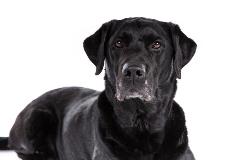Urinary Incontinence in Senior Dogs

Even when under the most watchful eyes, puppies may soil in the house. Until they have full control of their bladder and have figured out the importance of house training, accidents are bound to happen! Fortunately, most pups quickly figure out what they need to do. Why then, several years down the road, do we see signs that these same dogs seem to have forgotten what they learned?
Urinary Incontinence
When an older animal undergoes a change in its normal pattern of urination, it may be experiencing urinary incontinence, or a loss in bladder control
The following common signs often point to incontinence:- Wetting the bedding or floor where animal has been sleeping
- Dribbling of urine
- Increase in frequency of urinating
- Voiding bladder when excited or stressed.
Types of Urinary Incontinence
Health conditions found to be common in older dogs, and capable of affecting the bladder and causing urinary incontinence include, for instance:- Hormone-responsive incontinence
- Cause:
- Lack of hormones that help to maintain the muscle tone of the urethral sphincter
- Estrogen in females
- Testosterone in males
- Most common in middle-aged and older spayed females, but is noted to occur in young females and older neutered males
- Common symptom:
- Animal will wet when sleeping or when relaxed, but otherwise urinates normally
- Treatment:
- Prescribed medication that works to increase the muscle tone of the urethral sphincter, such as phenylpropanolamine
- Neutered male dogs also respond to being given testosterone
- Neurogenic incontinence
- Cause:
- Bladders with a compromised nerve supply lose muscle tone and the ability to contract
- Observed in animals with conditions that interfere with the nerves that control the bladder, for example:
- Spinal cord injuries
- Inherited neuropathies
- Infections
- Tumors
- Common symptoms:
- Intermittent, uncontrolled dribbling of urine
- Licking at penis or vulva
- Pain
- Voiding frequently, but in small amounts
- Passing mucus, bloody urine or blood clots
- Inability to pass urine after prolonged squatting or lifting of leg
- Treatment:
- Can be difficult, but may include:
- Long-term catheterization
- Antibiotics
- Drugs that act on the function of the bladder
- Overly distended bladder
- Cause:
- Partially obstructed bladder caused by, for example:
- Urethral stones
- Tumor
- Stricture
- Common symptoms:
- Signs are similar to animals with neurogenic incontinence, but are without a damaged nerve supply
- Urine dribbling is intermittent and uncontrolled
- Pain and swelling of the lower abdomen
- Treatment:
- Indwelling catheter put in place until the bladder’s muscle tone strengthens
- Drug therapy
- Kidney Failure
- Cause:
- Inability of kidneys to remove waste products from the blood which creates a buildup of toxins
- Common symptoms:
- Drinking and urinating more than usual which increases the animal’s need to go outside to urinate, and if they can’t get outside they will begin soil in the house
- Treatment:
- When the symptoms are related to kidney failure, the implications of the disease require much more than providing a treatment for incontinence
- Clients need to know that if their pet is diagnosed with renal failure, the animal will require more water than usual, and will need to urinate more than usual.
As dogs age, they face an increased chance for becoming incontinent. Should the symptoms arise, maintaining the support of the animal’s health will require veterinary involvement.
Register for our free webinar with Dr. Heidi Lobprise to learn more: To Pee or Not to Pee - A Senior Pet Dilemma
Presented by: Covetrus and PRN Pharmacal
August 11, 2016 / 1:00 PM EST
REGISTER HERE: http://bit.ly/bl2016pee
Dog Owner’s Home Veterinary Handbook, 4th ed., D.M. Eldredge, L.D. Carlson, D.G. Carlson, J.M. Giffin
Need Regulatory Assistance
If you need help with regulatory or licensing issues, we're happy to help. We have a wide variety of resources to help you when issues arise.

Careers
Are you looking for a place to let your talents shine? At Covetrus, we help our practitioner customers better serve their patients and take pride in providing the best customer experience possible. Search our open positions to see our available opportunities.
Newsletter
Stay current with what’s going on with Covetrus, subscribe to receive our newsletter and email communications. Subscribers will receive the latest information in practice management, sales and marketing, animal health, and more.


Leave a comment